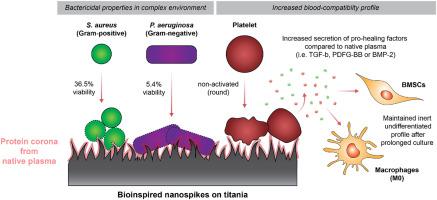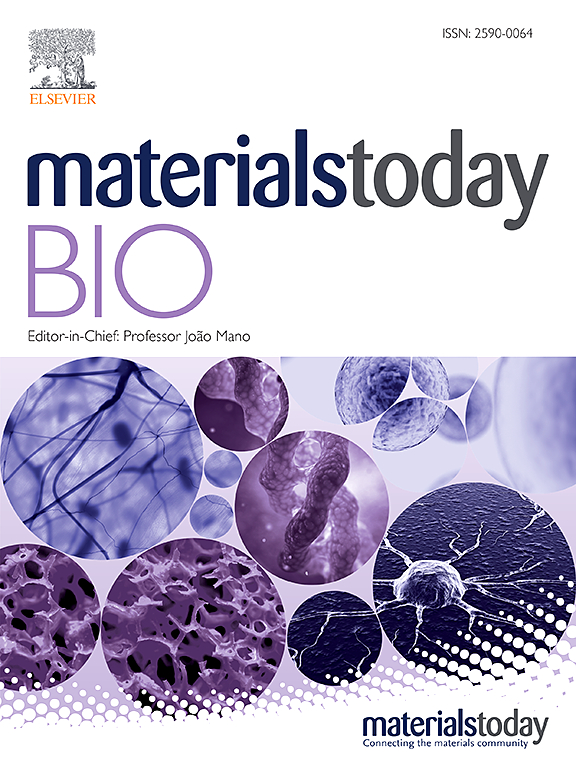用人血浆钝化的抗菌生物启发纳米结构的血小板相互作用和性能
IF 8.7
1区 医学
Q1 ENGINEERING, BIOMEDICAL
引用次数: 0
摘要
随着世界人口老龄化的不断加剧,人们对骨科设备提出了更高的要求。植入物感染、骨结合不良或慢性炎症等问题仍然是影响植入物寿命和长期功效的难题。制造具有生物启发的纳米结构的材料是防止植入物感染的一种新兴抗菌策略,但它们与血液成分的相互作用,以及它们在显示复杂蛋白质电晕的环境中是否能保持其杀菌特性,在很大程度上仍有待探索。在本研究中,对钛合金、市售纯钛和等离子喷涂的二氧化钛进行了热液蚀刻,并用人体原生血浆钝化以形成蛋白电晕,然后与金黄色葡萄球菌、绿脓杆菌或人体血小板一起培养。首先进行表面分析,以确定每种材料的形貌、化学成分或结晶度。荧光染色和扫描电镜用于评估纳米结构的杀菌特性,以及研究血小板的附着和形态。使用 ELISA 和流式细胞术研究了血小板上清液的成分。总之,我们的研究表明,生物启发纳米结构表面不仅在复杂环境中显示出令人印象深刻的抗菌特性,而且在血小板活化方面(尤其是钛合金)显示出卓越的血液生物相容性。此外,研究还发现血小板释放的促炎细胞因子数量与原生血浆(本底水平)无异,在某些情况下,血小板释放的促愈合因子(如 TGF-β、PDGF-BB 或 BMP-2)分泌量增加,显示出更强的促愈合特性。纳米结构表面的性能与羟基磷灰石涂层钛相当,甚至更好,而羟基磷灰石涂层钛是目前矫形外科的黄金标准之一。尽管还需要进一步的体内研究来验证这些结果,但这种由生物启发的纳米结构表面无疑显示出安全应用于骨科和其他领域的医疗设备表面的前景。本文章由计算机程序翻译,如有差异,请以英文原文为准。

Platelet interaction and performance of antibacterial bioinspired nanostructures passivated with human plasma
The ever-increasing ageing of the world population is demanding superior orthopedic devices. Issues such as implant infection, poor osseointegration, or chronic inflammation remain problematic to the lifespan and long-term efficacy of implants. Fabrication of materials with bioinspired nanostructures is one emerging antibacterial strategy to prevent implant infection, however their interactions with blood components, and whether they retain their bactericidal properties in an environment displaying a complex protein corona, remains largely unexplored. In the present study, titanium alloy, commercially pure and plasma-sprayed titania were hydrothermally etched, passivated with human native plasma to develop a protein corona, and then incubated with either Staphylococcus aureus, Pseudomonas aeruginosa or human platelets. Surface analysis was first used to characterize the topography, chemical composition or crystallinity of each material. Fluorescence staining and SEM were performed to evaluate the nanostructure bactericidal properties, as well as to study platelet attachment and morphology. Composition of platelet supernatant was studied using ELISA and flow cytometry. Overall, our study showed that the bioinspired nanostructured surfaces displayed both impressive antibacterial properties in a complex environment, and a superior blood biocompatibility profile in terms of platelet activation (particularly for titanium alloy). Additionally, the amount of pro-inflammatory cytokines released by platelets was found to be no different to that found in native plasma (background levels) and, in some cases, presented a more pro-healing profile with an increased secretion of factors such as TGF-β, PDGF-BB or BMP-2. The nanostructured surfaces performed equally, or better, than hydroxyapatite-coated titanium which is one of the current gold standards in orthopedics. Although further in vivo studies are required to validate these results, such bioinspired nanostructured surfaces certainly show promise to be safely applied to medical device surfaces used in orthopedics and other areas.
求助全文
通过发布文献求助,成功后即可免费获取论文全文。
去求助
来源期刊

Materials Today Bio
Multiple-
CiteScore
8.30
自引率
4.90%
发文量
303
审稿时长
30 days
期刊介绍:
Materials Today Bio is a multidisciplinary journal that specializes in the intersection between biology and materials science, chemistry, physics, engineering, and medicine. It covers various aspects such as the design and assembly of new structures, their interaction with biological systems, functionalization, bioimaging, therapies, and diagnostics in healthcare. The journal aims to showcase the most significant advancements and discoveries in this field. As part of the Materials Today family, Materials Today Bio provides rigorous peer review, quick decision-making, and high visibility for authors. It is indexed in Scopus, PubMed Central, Emerging Sources, Citation Index (ESCI), and Directory of Open Access Journals (DOAJ).
 求助内容:
求助内容: 应助结果提醒方式:
应助结果提醒方式:


